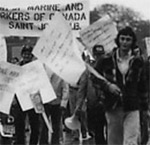
MARCHE DE PROTESTATION À SAINT-JEAN EST, 14 OCTOBRE 1976 : Des manifestants qui s'étaient rassemblés au Dry Dock marchent le long de la Bayside Drive jusqu'au King's Square.
This is a timely book that tells us how Canadian workers 30 years ago resisted a vicious government attack on their living standards. To my knowledge very little has been written about this significant event in our Canadian labour history. This book is important because it is written by a worker who was an active organizer of the general strike of 14 October 1976 in Saint John, New Brunswick. I was privileged to have worked with George Vair during that period. He was always a force in being able to organize the defence of workers' rights.
Thirty years later he is using his dedication to the labour movement to bring us this piece of history. He has been able here to capture the events and the interesting story that emerged out of Saint John. This contribution to our better understanding of labour events should serve as a model for other workers to tell their story using their precious knowledge and memory. We need more accounts like this one that can be presented to workers, the labour movement, and to the public in general.
The book clearly shows how wage controls were a threat to the free collective bargaining process. Because of high inflation workers across the country had negotiated substantial wage increases to try to catch up. In New Brunswick, many workers were also looking at parity with Central Canada and had negotiated adjustments that were threatened by the controls. Pierre Elliott Trudeau's program was simply an attack on organized labour and in no way had any effect in controlling the high inflation that was experienced by Canadian workers. The book shows us how workers were betrayed when the government interfered with the bargaining process in such an unprecedented way.
We are also reminded of the debate that took place within the labour movement in response to the wage controls when they first came into effect. Things are never simple when it comes to defending workers' rights. This is particularly true when you are under attack by the federal government with the support of all provinces and the business community. Without name-calling Brother Vair gives us a good insight into where the leadership of the labour movement stood in relation to this major attack. His recollections of the events around the big demonstration in Ottawa on 22 March and the big public meeting in Saint John on 28 March, revived a lot of good memories for me and show how we are able to inform and mobilize in the labour movement.
Brother Vair's accounts of the Canadian Labour Congress (CLC) convention in May 1976 and of the New Brunswick Federation of Labour convention in June are particularly interesting. He brings very good insight into the debate around the issue of how far the labour movement was prepared to go in opposing the controls. His recollection of the debates and of the politics of the time is very thoughtful. His appreciation of Lofty MacMillan's candidacy to become president of the CLC at this convention is honest and straightforward. More importantly, he explains how upon returning from the CLC convention he felt it was more important than ever to fight the controls with a general strike.
His detailed account of how they mobilized the workers in Saint John is great information for workers reading this book. It shows that leadership of the labour movement has to work very hard with all possible allies in order to educate the membership to fight unfair measures. For many weeks before 14 October 1976, the coordinating committee of the Saint John District Labour Council met and worked hard to prepare for this mobilization. Workers were angry about their unfair treatment, but they needed to be organized, and the focus of this action was the general strike. In retrospect, after reading these pages I wonder what impact we could have had if every community had organized the way labour leaders did in Saint John.
Although the general strike was not as successful in other areas as it was in Saint John, the conclusions drawn in this book are very interesting. Important lessons were learned. Workers across the country saw their respective governments in a very different light after October 1976. Brother Vair is correct in stating that the organizing skills learned during that campaign were very helpful in fighting concessions in the next decade. That struggle helped to make the Canadian labour movement a better and more progressive movement.
It is a wonderful pleasure to read this kind of history, written by a friend and fellow trade unionist. He tells us his personal experience as a local labour activist in Saint John, but he also tells us a story that needs to be known all across the country. He shows us what governments can and will do to keep workers in their place, and he shows us how organized labour can make a difference when we mobilize. For all these reasons I encourage you to read this book, share it with your friends and bring it to the attention of other workers.
Source : George Vair, The Struggle against Wage Controls : The Saint John Story, 1975-1976, (Saint-Jean, Terre-Neuve, Comité canadien sur l'histoire du travail, 2006), p. 9-11.